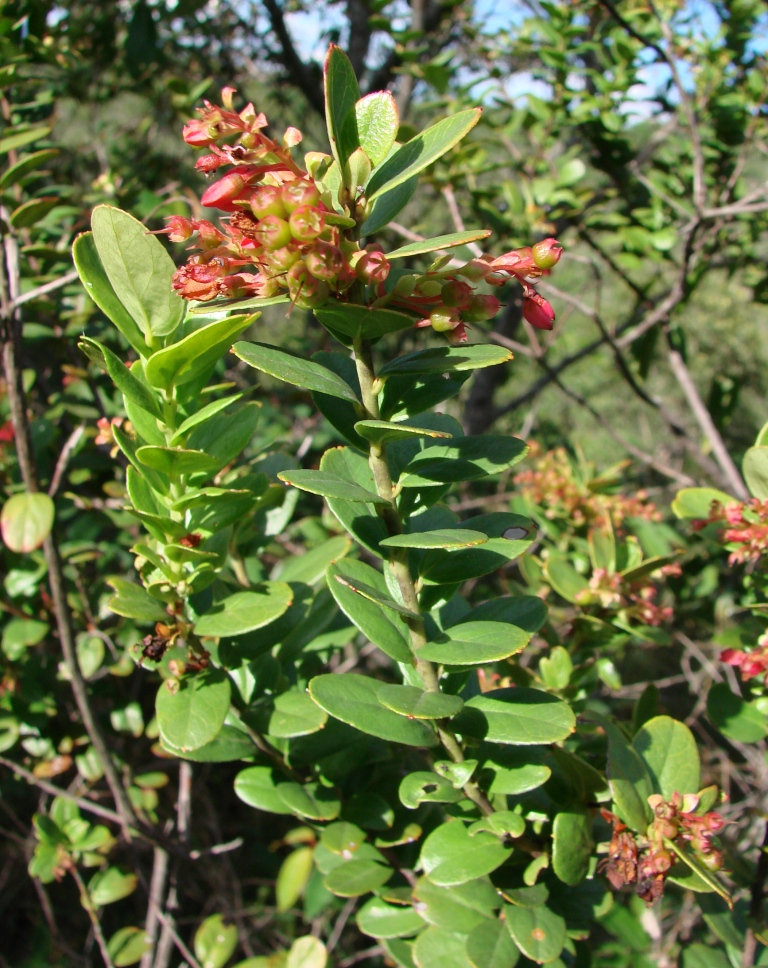|
Oak–heath Forest
An oak–heath forest is a plant community association and type of forest ecology. It is a deciduous forest type of well-drained, acidic soils, characterized by oaks (''Quercus'') and plants of the heath family (Ericaceae). It is commonly found in the high elevations of the eastern United States. Such forest areas typically have a dense fibrous root layer at the surface of the soil, and in many areas predominate on south-facing or southwest-facing slopes. Many of the existing oak–heath forests once featured American chestnut as an important canopy species.''The Natural Communities of Virginia Classification of Ecological Community Groups'' (Version 2.3), Virginia Department of Conservation and Recr ... [...More Info...] [...Related Items...] OR: [Wikipedia] [Google] [Baidu] |
Plant Community
A plant community is a collection or Association (ecology), association of plant species within a designated geographical unit, which forms a relatively uniform patch, distinguishable from neighboring patches of different vegetation types. The components of each plant community are influenced by soil type, topography, climate and human disturbance. In many cases there are several soil types present within a given plant community. This is because the soil type within an area is influenced by two factors, the rate at which water infiltrates or exits (via evapotranspiration) the soil, as well as the rate at which organic matter (any carbon-based compound within the environment, such as decaying plant matter) enters or decays from the soil. Plant communities are studied substantially by ecologists, due to providing information on the effects of dispersal, tolerance to environmental conditions, and response to disturbance of a variety of plant species, information valuable to the comprehe ... [...More Info...] [...Related Items...] OR: [Wikipedia] [Google] [Baidu] |
Heath
A heath () is a shrubland habitat found mainly on free-draining infertile, acidic soils and is characterised by open, low-growing woody vegetation. Moorland is generally related to high-ground heaths with—especially in Great Britain—a cooler and damper climate. Heaths are widespread worldwide but are rapidly disappearing and considered a rare habitat in Europe. They form extensive and highly diverse communities across Australia in humid and sub-humid areas where fire regimes with recurring burning are required for the maintenance of the heathlands.Specht, R.L. 'Heathlands' in 'Australian Vegetation' R.H. Groves ed. Cambridge University Press 1988 Even more diverse though less widespread heath communities occur in Southern Africa. Extensive heath communities can also be found in the Texas chaparral, New Caledonia, central Chile, and along the shores of the Mediterranean Sea. In addition to these extensive heath areas, the vegetation type is also found in scattered locations a ... [...More Info...] [...Related Items...] OR: [Wikipedia] [Google] [Baidu] |
Flora Of The Northeastern United States
Flora (: floras or florae) is all the plant life present in a particular region or time, generally the naturally occurring ( indigenous) native plants. The corresponding term for animals is ''fauna'', and for fungi, it is '' funga''. Sometimes bacteria and fungi are also referred to as flora as in the terms ''gut flora'' or ''skin flora'' for purposes of specificity. Etymology The word "flora" comes from the Latin name of Flora, the goddess of plants, flowers, and fertility in Roman mythology. The technical term "flora" is then derived from a metonymy of this goddess at the end of the sixteenth century. It was first used in poetry to denote the natural vegetation of an area, but soon also assumed the meaning of a work cataloguing such vegetation. Moreover, "Flora" was used to refer to the flowers of an artificial garden in the seventeenth century. The distinction between vegetation (the general appearance of a community) and flora (the taxonomic composition of a community) wa ... [...More Info...] [...Related Items...] OR: [Wikipedia] [Google] [Baidu] |
Ecoregions Of The United States
Lists of ecoregions in the United States may refer to: * List of ecoregions in the United States (EPA), United States Environmental Protection Agency system * List of ecoregions in the United States (WWF), World Wildlife Fund system {{list of lists, environment United States geography-related lists, Ecoregions ... [...More Info...] [...Related Items...] OR: [Wikipedia] [Google] [Baidu] |
Temperate Broadleaf And Mixed Forests In The United States
In geography, the temperate climates of Earth occur in the middle latitudes (approximately 23.5° to 66.5° N/S of the Equator), which span between the tropics and the polar regions of Earth. These zones generally have wider temperature ranges throughout the year and more distinct seasonal changes compared to tropical climates, where such variations are often small; they usually differ only in the amount of precipitation. In temperate climates, not only do latitudinal positions influence temperature changes, but various sea currents, prevailing wind direction, continentality (how large a landmass is) and altitude also shape temperate climates. The Köppen climate classification defines a climate as "temperate" C, when the mean temperature is above but below in the coldest month to account for the persistence of frost. However, some adaptations of Köppen set the minimum at . Continental climates are classified as D and considered to be varieties of temperate climates, h ... [...More Info...] [...Related Items...] OR: [Wikipedia] [Google] [Baidu] |
Epigaea Repens
''Epigaea repens'', the mayflower, trailing arbutus, or ground laurel, is a low, spreading shrub in the family Ericaceae. It is found from Newfoundland to Florida, west to Kentucky and the Northwest Territories. Description The plant is a slow-growing, prostrate to sprawling shrub that prefers moist, shady habitats and acidic (humus-rich) soil. It is often part of the heath complex in an oak-heath forest. Its stems are woody and the leafy twigs are covered in rust-colored hairs. The leaves are alternate, ovate (oval-shaped with rounded bases), evergreen, glabrous above and more or less hairy beneath, and borne on short rusty-hairy petioles. The flowers are pentamerous, pale pink to nearly white and very fragrant, about across when expanded, and borne in clusters at the ends of the branches. The calyx consists of five dry, overlapping sepals. The corolla is salverform, with a slender hairy tube spreading into five equal lobes. There are five stamens. The gynoecium consists of ... [...More Info...] [...Related Items...] OR: [Wikipedia] [Google] [Baidu] |
Gaultheria
''Gaultheria'' is a genus of about 283 species of shrubs in the family Ericaceae. The name commemorates Jean François Gaultier of Quebec, an honour bestowed by the Scandinavian Pehr Kalm in 1748 and taken up by Carl Linnaeus in his '. These plants are native to Asia, Australasia and North and South America. In the past, the Southern Hemisphere species were often treated as the separate genus ''Pernettya'', but no consistent reliable morphological or genetic differences support recognition of two genera, and they are now united in the single genus ''Gaultheria''. Description The species vary from low, ground-hugging shrubs less than tall, up to tall, or, in the case of '' G. fragrantissima'' from the Himalayas, even a small tree up to tall. The leaves are evergreen, alternate (opposite in '' G. oppositifolia'' from New Zealand), simple, and vary between species from long; the margins are finely serrated or bristly in most species, but entire in some. The flowers ar ... [...More Info...] [...Related Items...] OR: [Wikipedia] [Google] [Baidu] |
Chimaphila
''Chimaphila'' (prince's pine or wintergreen; from Greek: ''cheima'' 'winter' and ''philos'' 'lover', hence 'winter lover') is a genus of five species of small, evergreen, flowering plants native to temperate regions of the Northern Hemisphere. They are classified in the family Ericaceae, but were formerly placed in the segregate family Pyrolaceae. ;Species *'' Chimaphila japonica'' *'' Chimaphila maculata'' (spotted wintergreen, also called striped wintergreen, striped prince's pine or rheumatism root) *'' Chimaphila menziesii'' (little prince's pine) *'' Chimaphila monticola'' *''Chimaphila umbellata ''Chimaphila umbellata'', the umbellate wintergreen, pipsissewa, or prince's pine, is a small perennial flowering plant found in dry woodlands, or sandy soils. It is native throughout the cool temperate Northern Hemisphere. Description This pl ...'' (umbellate wintergreen, pipsissewa, or prince's pine) References Flora of China: ''Chimaphila'' Ericaceae genera {{ ... [...More Info...] [...Related Items...] OR: [Wikipedia] [Google] [Baidu] |
Rhododendron
''Rhododendron'' (; : ''rhododendra'') is a very large genus of about 1,024 species of woody plants in the Ericaceae, heath family (Ericaceae). They can be either evergreen or deciduous. Most species are native to eastern Asia and the Himalayan region, but smaller numbers occur elsewhere in Asia, and in North America, Europe and Australia. It is the national flower of Nepal, the List of U.S. state and territory flowers, state flower of Washington (state), Washington and West Virginia in the United States, the state flower of Nagaland and Himachal Pradesh in India, the provincial flower of Jeju Province in South Korea, the provincial flower of Jiangxi in China and the List of Indian state trees, state tree of Sikkim and Uttarakhand in India. Most species have brightly coloured flowers which bloom from late winter through to early summer. Azaleas make up two subgenera of ''Rhododendron''. They are distinguished from "true" rhododendrons by having only five anthers per flower. E ... [...More Info...] [...Related Items...] OR: [Wikipedia] [Google] [Baidu] |
Oxydendrum Arboreum
''Oxydendrum arboreum'', the sourwood or sorrel tree, is the sole species in the genus ''Oxydendrum'', in the family Ericaceae. It is native to eastern North America, from southern Pennsylvania south to northwest Florida and west to southern Illinois; it is most common in the lower chain of the Appalachian Mountains. The tree is frequently seen as a component of oak-heath forests. Growth Sourwood is a small tree or large shrub, growing to tall with a trunk up to diameter. Occasionally on extremely productive sites, this species can reach heights in excess of 30 meters and 60 cm diameter. The leaves are alternately arranged, deciduous, long and broad, with a finely serrated margin; they are dark green in summer, but turn vivid red in fall. The flowers are white, bell-shaped, 6–9 mm ( 1/4 to 1/3 inch) long, produced on long panicles. The fruit is a small woody capsule. The roots are shallow, and the tree grows best when there is little root competition; ... [...More Info...] [...Related Items...] OR: [Wikipedia] [Google] [Baidu] |
Gaylussacia
''Gaylussacia'' is a genus of about fifty species of flowering plants in the family Ericaceae, native to the Americas, where they occur in eastern North America and in South America in the Andes and the mountains of southeastern Brazil (the majority of the known species). Common English names include huckleberry (shared with plants in several other genera) and "dangleberry". ''Gaylussacia'' plants are often a component of an oak-heath forest. They are deciduous or evergreen shrubs growing to a height of . Ecology ''Gaylussacia'' species are used as food plants by the larvae of some Lepidoptera (butterflies and moths) species including '' Coleophora gaylussaciella'' (which feeds exclusively on ''Gaylussacia'') and '' Coleophora multicristatella''. Classification ''Gaylussacia'' is named in honor of the French chemist Joseph Louis Gay-Lussac (1778–1850). It is closely related to ''Vaccinium'', and it is still unclear whether the commonly understood line between ''Vaccinium'' ... [...More Info...] [...Related Items...] OR: [Wikipedia] [Google] [Baidu] |
Vaccinium
''Vaccinium'' is a common and widespread genus of shrubs or dwarf shrubs in the heath family (Ericaceae). The fruits of many species are eaten by humans and some are of commercial importance, including the cranberry, blueberry, bilberry (whortleberry), lingonberry (cowberry), and huckleberry. Like many other heath plants, they are restricted to acidic soils. Description The plant structure varies between species: some trail along the ground, some are dwarf shrubs, and some are larger shrubs perhaps tall. Some tropical species are epiphytic. Stems are usually woody. Flowers are epigynous with fused petals and have long styles that protrude from their bell-shaped corollas. Stamens have anthers with extended tube-like structures called "awns" through which pollen falls when mature. Inflorescences can be axillary or terminal. The fruit develops from an inferior ovary and is a four- or five-parted berry; it is usually brightly coloured, often red or bluish with purple juice. ... [...More Info...] [...Related Items...] OR: [Wikipedia] [Google] [Baidu] |





